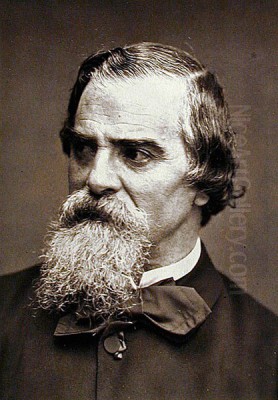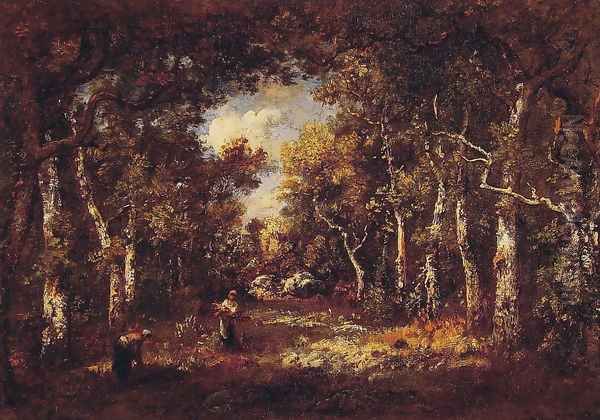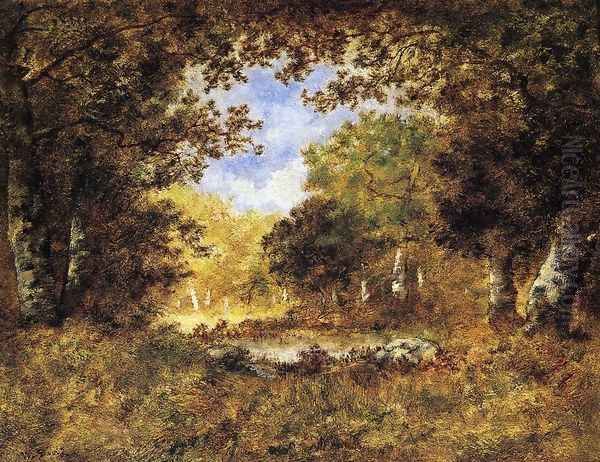
Narcisse-Virgile Diaz de la Peña (1808-1876) stands as a significant figure in 19th-century French art, a painter whose life was as dramatic and richly textured as his canvases. Born of Spanish parentage in Bordeaux, France, he became a pivotal member of the Barbizon School, a group of artists who revolutionized landscape painting by emphasizing direct observation of nature. Diaz's work, however, was not confined to pure naturalism; it often carried a strong Romantic sensibility, imbued with imaginative figures, vibrant color, and a masterful play of light and shadow that set him apart from some of his more austere contemporaries. His journey from a childhood marked by tragedy to a celebrated artist is a testament to his resilience and unwavering dedication to his craft.
Early Life: Tragedy and a Fateful Turn
Narcisse-Virgile Diaz de la Peña was born on August 25, 1808, in Bordeaux. His parents were Spanish political refugees who had fled the turmoil in their homeland under Joseph Bonaparte. This Spanish heritage would subtly inform his artistic temperament throughout his life. His early years were fraught with hardship. His father passed away when Narcisse was still very young, and his mother, seeking a livelihood, moved to Burgundy, leaving the young boy effectively an orphan by the age of ten. He found refuge with a Protestant pastor in Bellevue, near Meudon, who took him in and provided some stability during these formative years.

A defining and tragic event occurred when Diaz was around thirteen years old. While playing in the Meudon woods, or perhaps Sèvres, he suffered a severe bite from a snake or an insect on his left leg. The subsequent infection became so grave that it necessitated the amputation of the limb. This profound physical challenge, which forced him to rely on a wooden prosthetic for the rest of his life, paradoxically steered him towards a career in art. The sedentary nature of painting became a viable and compelling pursuit for a young man whose physical mobility was suddenly and permanently curtailed. This early encounter with the raw, sometimes cruel, beauty of nature, and the subsequent focus it demanded, arguably shaped his later artistic vision of the forest as a place of both enchantment and untamed power.
Artistic Apprenticeship and Emerging Talent
Diaz's formal artistic training began not with canvas and easel, but in the world of applied arts. Around the age of fifteen, he entered an apprenticeship at a porcelain factory in Sèvres, a renowned center for ceramic production. Here, he learned the meticulous art of painting on porcelain, a discipline that demanded precision, a steady hand, and a keen eye for color and design. This experience, though not directly fine art, provided him with a solid foundation in decorative techniques and color theory.
By 1823, he had moved to Paris and was working for another porcelain manufacturer, this time one specializing in "Chinese" style ceramics, under a man named Jacques-François Lecoeur. It was during this period that his ambition began to shift towards fine art painting. He started to paint small figures and landscapes, honing his skills independently. He sought out instruction where he could, briefly studying with the academic painter François Souchon, though Diaz was largely self-taught, absorbing lessons from the Old Masters he admired in the Louvre and from the burgeoning artistic currents of his time. His early works often featured figures, sometimes with mythological or Orientalist themes, reflecting the Romantic fascination with the exotic and the historical.
The Barbizon School and the Forest of Fontainebleau
The most significant development in Diaz de la Peña's artistic career was his association with the Barbizon School. This informal group of painters, active from roughly the 1830s to the 1870s, congregated around the village of Barbizon, situated on the edge of the vast Forest of Fontainebleau. Rejecting the idealized landscapes and historical subjects favored by the French Academy, the Barbizon painters advocated for a more direct, realistic, and personal engagement with nature. They were pioneers of plein air (open-air) painting, though much of their finished work was still completed in the studio.

Diaz was drawn to this movement and its charismatic figures. He first exhibited at the Paris Salon in 1831 with a work titled Scène d'Amour (Love Scene), but it was his encounters with the Forest of Fontainebleau and its artistic interpreters that truly defined his path. He became a close associate and admirer of Théodore Rousseau, one of the leading figures of the Barbizon School. Rousseau, known for his profound and often melancholic depictions of the forest, became a mentor to Diaz, particularly in the art of painting trees and capturing the intricate structures and unique character of the woodland. Diaz learned from Rousseau the importance of immersing oneself in the landscape, observing its changing moods, light, and textures.
Other key members of the Barbizon group with whom Diaz interacted and shared artistic ideals included Jean-François Millet, famous for his dignified portrayals of peasant life; Jules Dupré, known for his dramatic and turbulent landscapes; Charles-François Daubigny, who often painted tranquil river scenes from his studio boat; and Constant Troyon, celebrated for his animal paintings set in natural landscapes. While each artist had a distinct style, they shared a common reverence for nature and a commitment to portraying it with honesty and emotion. Diaz, with his vibrant palette and often more imaginative compositions, brought a unique flair to the group.
Key Artistic Influences
Beyond his Barbizon colleagues, Diaz de la Peña's artistic vision was shaped by a diverse range of influences. His early figure paintings and his rich use of color show the impact of the great Romantic painter Eugène Delacroix. Diaz admired Delacroix's dramatic compositions, his expressive brushwork, and his fascination with Orientalist themes – subjects that Diaz himself would explore, often depicting figures in Turkish or Bohemian attire, adding a touch of exoticism to his forest scenes or creating standalone genre pieces.
The Rococo charm and sensuousness of 18th-century masters like Antoine Watteau and François Boucher can also be discerned in some of Diaz's works, particularly in his depictions of nymphs, goddesses, and amorous encounters nestled within sylvan settings. He was drawn to their playful elegance and decorative qualities.
Furthermore, Diaz studied the works of Renaissance and Baroque masters. He was particularly captivated by the Venetian school's mastery of color and light, and he drew inspiration from artists like Correggio, whose mythological scenes, such as Sleeping Nymph, resonated with Diaz's own interest in combining the human figure with lush natural backdrops. The soft, sfumato effects and idealized figures in the work of Pierre-Paul Prud'hon, such as Venus Disarming the Warrior and Education of Love, also left an impression on Diaz, influencing his treatment of form and his creation of poetic, dreamlike atmospheres. The influence of Spanish masters, perhaps an echo of his heritage, can also be felt in the dramatic chiaroscuro that often characterizes his work.
Artistic Style, Themes, and Techniques
Diaz de la Peña's mature style is characterized by a rich, jewel-like palette, a fascination with the effects of light filtering through dense foliage, and a textured, often impastoed, application of paint. While he was a dedicated observer of nature, his landscapes were rarely mere topographical records. Instead, he imbued them with a sense of mystery, drama, and enchantment.
The Forest of Fontainebleau was his principal muse. He was particularly adept at capturing the "sous-bois" – the forest undergrowth – with its tangled branches, mossy rocks, and dappled sunlight. His forest interiors are often deep and shadowy, with sudden bursts of light illuminating a clearing, a pool of water, or the vibrant autumn leaves. This dramatic interplay of light and dark, or chiaroscuro, became a hallmark of his style, creating a sense of depth and a theatrical ambiance. He was less interested in the vast, panoramic views favored by some landscape painters and more focused on the intimate, enclosed spaces within the woods.
While landscapes formed the core of his oeuvre, Diaz frequently populated them with figures. These could be mythological beings like nymphs, cupids, and goddesses, or more earthly figures such as peasants, children, or elegantly dressed ladies. His Orientalist figures, often sumptuously costumed, added an element of fantasy and exoticism. These figures were not always central to the composition but often served to enhance the mood or provide a focal point within the larger natural setting.
His technique involved building up layers of paint, often allowing the texture of the brushstrokes to remain visible. This gave his surfaces a vibrant, tactile quality. He was a brilliant colorist, using rich greens, deep browns, and russets for the forest, often punctuated by touches of brilliant red, yellow, or blue in the figures' costumes or in autumnal foliage.
Representative Masterpieces
Narcisse-Virgile Diaz de la Peña produced a substantial body of work, many of which are now housed in major museums around the world. Among his most celebrated paintings are:
_La Fée aux Perles_ (The Fairy with Pearls, 1857, Musée du Louvre, Paris): This iconic work exemplifies Diaz's blend of landscape and fantasy. A luminous fairy, adorned with pearls, is set within a richly painted, dark forest clearing, showcasing his mastery of light and romantic subject matter.
_Sunset in the Forest_ (1868, Tate, London): This painting captures the evocative atmosphere of the woods at dusk, with the warm glow of the setting sun filtering through the trees, highlighting Diaz's skill in rendering complex light effects and his deep connection to the Forest of Fontainebleau.
_The Storm_ (c. 1870s, Leeds Art Gallery): A powerful and dramatic depiction of nature's fury, this work showcases Diaz's ability to convey movement and atmosphere through vigorous brushwork and a somber palette, characteristic of the Barbizon interest in the sublime aspects of nature.
_The Forest of Fontainebleau_ (1867, Metropolitan Museum of Art, New York; other versions exist, e.g., 1870, Leeds Art Gallery): Numerous paintings bear this title or similar, each a testament to his enduring fascination with this location. These works typically feature dense woodlands, dappled sunlight, and an intimate perspective.
_The Frog Pond_ (National Gallery of Art, Washington D.C.): This work likely depicts a tranquil scene within the forest, focusing on the reflective qualities of water and the lush surrounding vegetation, a common theme for Barbizon painters.
_Valley Marshes_ (Los Angeles County Museum of Art): Suggests a broader landscape than his typical forest interiors, perhaps exploring the marshy outskirts of Fontainebleau, offering a different play of light and texture.
_The Approaching Storm_ (Norton Simon Museum, Pasadena): Similar to The Storm, this painting would focus on the dramatic build-up of weather, a theme that allowed Diaz to explore dynamic compositions and emotional intensity in nature.
_Pond in the Woods_ (Rijksmuseum Twenthe, Enschede): Another example of his favored forest interiors, likely featuring a secluded pond reflecting the sky and trees, creating a sense of peace and enclosure.
_Men in Oriental Costumes_ (Los Angeles County Museum of Art): This work highlights his interest in Orientalist themes, showcasing his skill in rendering rich fabrics and exotic figures, often placed within a natural or vaguely defined setting.
_Cows by the Pond_ (National Gallery of Art, Washington D.C.): While not as common as his pure landscapes or mythological scenes, this indicates his engagement with the pastoral elements also explored by fellow Barbizon artists like Troyon.
These works, and many others, demonstrate his versatility, his rich imagination, and his profound connection to the natural world, filtered through a Romantic lens.
Friendships, Collaborations, and Artistic Interactions
Diaz de la Peña was a sociable and well-liked figure within the artistic community. His relationship with Théodore Rousseau was particularly crucial, evolving from mentorship to a deep friendship. They often painted together in Fontainebleau, sharing insights and encouraging each other. He was also close to Jules Dupré, another stalwart of the Barbizon School, with whom he shared a passion for capturing the expressive power of nature.
His influence extended to the next generation of artists. He formed a notable friendship with the young Pierre-Auguste Renoir. Legend has it that Diaz once intervened to protect Renoir from ruffians in the Forest of Fontainebleau and subsequently offered him encouragement and advice, particularly regarding the use of color. Renoir later acknowledged Diaz's impact, especially in brightening his palette. Diaz also knew Claude Monet and other emerging Impressionists, and his emphasis on light and color, as well as his textured brushwork, can be seen as a precursor to some Impressionistic techniques.
Diaz also interacted with figures beyond the Barbizon circle. His early admiration for Eugène Delacroix was significant, and while direct collaboration might have been limited, Delacroix's Romantic spirit certainly resonated with Diaz. He participated in exhibitions alongside a wide array of artists, including more academic figures like Paul Delaroche and fellow landscape painters like Eugène Boudin, who himself would become a mentor to Monet. The artistic world of Paris and Barbizon was a vibrant network, and Diaz was an active participant in its dialogues and exchanges. He also knew the writer Victor Hugo, another towering figure of French Romanticism.
Later Years, Recognition, and Challenges
Diaz de la Peña achieved considerable success during his lifetime. His works were popular with collectors, and he exhibited regularly at the Paris Salon, winning a first-class medal in 1848 and the Grand Prize at the Paris Salon in 1851. In that same year, 1851, he was made a Chevalier of the Legion of Honour, a significant recognition of his artistic contributions. The provided information also mentions an 1881 Legion of Honour, which, given his death in 1876, would have been a posthumous honor or possibly refers to a different grade or a misunderstanding in the source material; the 1851 award is widely documented.
Despite his successes, his life was not without its difficulties. The Franco-Prussian War (1870-1871) prompted him to spend time in Brussels. After the war, his popularity with collectors grew, yet sources suggest he still faced periods of financial strain towards the end of his life, a common plight for many artists of the era, even those who achieved a degree of fame.
His health, perhaps always somewhat fragile due to his early amputation and the physical demands of his work, began to decline. Narcisse-Virgile Diaz de la Peña passed away on November 18, 1876, in Menton, a town on the French Riviera known for its milder climate, where he had likely gone seeking relief. He was 68 years old.
Legacy and Enduring Impact
Narcisse-Virgile Diaz de la Peña left an indelible mark on 19th-century French painting. As a key member of the Barbizon School, he played a vital role in the shift towards naturalism and plein air painting, paving the way for Impressionism. His unique contribution was to infuse the Barbizon ethos with a strong dose of Romanticism, creating landscapes that were not only observed but also deeply felt and imagined.
His rich color harmonies, his masterful handling of light and shadow, and his ability to evoke a sense of mystery and enchantment in his forest scenes distinguished his work. He demonstrated that landscape painting could be a vehicle for profound personal expression and poetic fantasy. His influence on younger artists, notably Renoir, underscores his importance as a transitional figure.
Today, Diaz de la Peña's paintings are held in the collections of major museums worldwide, including the Musée d'Orsay and the Louvre in Paris, the Metropolitan Museum of Art in New York, the National Gallery in London, the Wallace Collection (referred to as Hertford Museum in some older texts), and many others. His work continues to be admired for its beauty, its technical skill, and its evocative power, securing his place as a significant and beloved master of French landscape and Romantic painting. His life story, marked by early adversity overcome through artistic passion, remains an inspiring narrative of dedication and creative triumph.